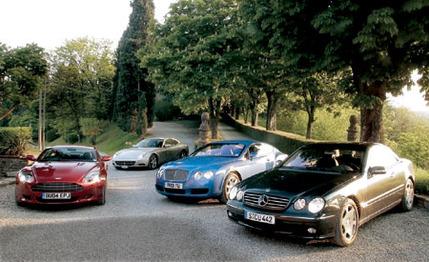 Comparison Tests
Comparison Tests
No need to explain why we put these cars together. Here are four high-end, highly desirable front-engined coupes, each with a 12-cylinder engine of 5.5-plus liters of displacement, a power output between 444 and 551 horsepower, and four seats.
These are the new grand tourers as the term was understood before it was debased by being commonly attached to regular sedans. But the original purpose of a GT car-the crossing of continents at high speeds and in great comfort-is an anachronism today. In the 1930s, Bentleys raced the Blue Train from Paris to Nice on France's Côte d'Azur. Today's Bentleys are more likely to be delivering the owner to his or her executive jet. Speed limits and traffic density make long-distance road travel at 150 mph somewhat impractical and, in most places, illegal.
So what is the purpose of these mighty and extravagant cars? Maybe it's just show. "Hey! Over here! I'm rich!" Or perhaps it's to prove that an older generation can still appreciate supercars and great performance without having to play contortionist and climb into some low-slung projectile that can accommodate no more luggage than a platinum credit card.
Either way, there is new interest in this kind of car because of recent arrivals. The latest of these European luxury coupes are the Ferrari 612 Scaglietti F1 and the Aston Martin DB9, introduced simultaneously this spring. They follow hard on the taillights of the Bentley Continental GT, the first all-new Bentley to be produced under Volkswagen's ownership of the British firm.
We put these three newcomers up against the latest version of an old-stager. There is a horsepower race going on in Europe, and Mercedes-Benz is the most fervent competitor. The CL600, originally designed for comfort rather than speed, now has a twin-turbo version of its 5.5-liter V-12 engine that develops 493 horsepower. If that's not enough firepower, a 6.0-liter AMG version, called the CL65, has 604 horses. We tried to acquire one of those for this comparison but were unsuccessful. The standard CL600 was, at $130,070, the least expensive car in this test but very nearly the quickest. The CL600 may not look and seem as special as the others, but this Benz is a high achiever.
In three days of driving through northern Italy, we examined every aspect of these four fascinating machines. We drove them on winding country roads in Lombardy, on highways that were straight kilometer after kilometer but that also included challenging high-speed sweepers and disconcerting plunges into curving tunnels.
And although these cars have similar powertrains and layouts, produce almost the same greatly impressive performance figures, and cover correspondingly few miles per gallon, they appeal in distinct ways and vary enormously in price-the most expensive, the Ferrari, being twice the price of the Mercedes.
The highway was no place to verify the exalted performance claims for these cars, so we rented the Vairano proving ground near Milan, owned by the Italian magazine Quattroruote, where it was possible to measure acceleration up to and including 150 mph, as well as conduct all our other test procedures.
The Vairano straight, at 1.2 miles, was not long enough for maximum flat-out runs, but having confirmed all four manufacturers' claims for acceleration, we feel confident in quoting their top-speed figures, which, let's face it, are largely academic anyway. We can't imagine many Bentley owners, or even those who buy this kind of Ferrari, venturing close to 200 mph, but they just might want to go faster than the Mercedes' self-imposed 155-mph limit.
In two evenings at the Castello di Luzzano near Pavia, partaking of local pasta and malvasia, the delicious white wine of the house, we argued long and hard over these GTs, which are so similar in specification yet so different in character.
Do usable and comfortable rear seats matter? Is an automated manual transmission, as used by the Ferrari, appropriate for a car like this, or are the torque-converter automatics of the others a better proposition? With so much power available, is weight important, and if so, should we give extra kudos to the Aston and Ferrari for being aluminum? Then again, maybe none of this matters as much as do style and image, in which case, we all agreed, the Aston would win hands down.
As you will see, it didn't work out that way. When it came to the numbers crunch, the most expensive contender won, and the most practical car was a close second. Here's why: -Ray